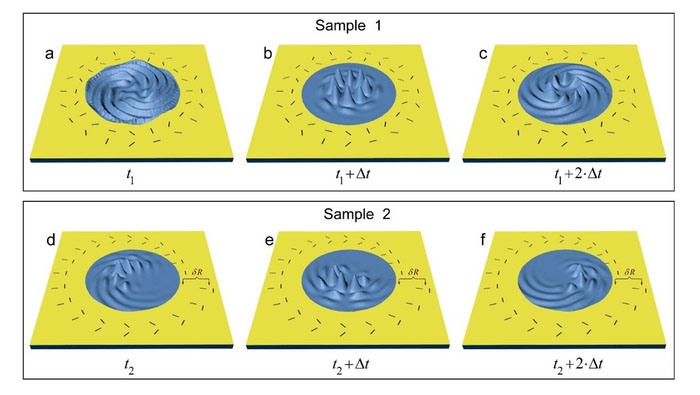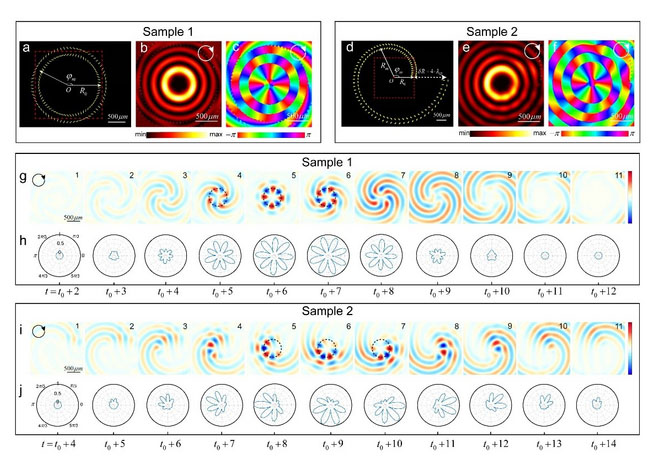| Jan 07, 2023 |
Tailoring spatiotemporal dynamics of plasmonic vortices
(Nanowerk News) Plasmonic vortex is an optical field distribution with topological features formed by interfering surface plasmons, which enriches the class of vortex phenomena in nature. Owing to their special orbital angular momentum feature in the evanescent field region, plasmonic vortices hold great promises for many cutting-edge applications, such as plasmonic tweezers for microparticle manipulations and on-chip quantum information processing.
|
|
The generation methods and evolution dynamics of plasmonic vortices have thus elicited great research enthusiasm in the last decade, which have provided many insights into the nature of plasmonic vortex and rapidly promoted the related applications forward.
|
|
For plasmonic vortex generation, the most common method is constructing special couplers and utilizing the design degrees of freedoms of propagation phase and geometric phase to convert circularly polarized light carrying spin angular momentum into on-chip plasmonic vortex. Despite the sole or combined use of propagation and geometric phase can all achieve plasmonic vortex of target topological charge, the actual differences of their spatiotemporal dynamics have remained unexplored.
|
|
For characterization methods, the currently used photoemission electron microscopy and nonlinear near-field optical microscopy are limited by the probing principle and optical systems, thus can hardly obtain the exact evolution dynamics. The research documented by this article mainly focused on the objective characterization of plasmonic vortex and the subjectively tailoring of its spatiotemporal dynamics for specific applications has not been achieved.
|
|
A research group from Tianjin University, Guilin University of Electronic Technology and authors of this article (Opto-Electronic Advances, "Tailoring spatiotemporal dynamics of plasmonic vortices") propose a new method to tailor the spatiotemporal dynamics of plasmonic vortices. It is demonstrated that the plasmonic vortices with the same topological charge can be endowed with distinct spatiotemporal dynamics by simply changing the coupler design (Fig 1).
|
 |
| Fig 1. Schematic diagram of the temporal evolution process of plasmonic vortices with the same topological charge generated by different couplers. (a-c) Sample 1 introduces only the geometric phase through varying the orientation angles of the slit resonators. (d-f) Sample 2 introduces both geometric phase and propagation phase through varying the radial position of slit-pairs. (© Opto-Electronic Advances)
|
|
The full amplitude and phase information of surface plasmons fields and the exact evolution dynamics with ultrahigh temporal resolution were directly obtained based on a near-field scanning terahertz microscopy.
|
|
Based on the orthogonal slit-pairs, the group designed two plasmonic vortex couplers to generate plasmonic vortices with the same topological charge (l = 4). By introducing different propagation phase and geometric phase, the spatiotemporal dynamics of generated plasmonic vortices can be totally different. In order to numerically reveal the processes of the formation, revolution and decay stages in the lifetime of plasmonic vortex, the group generalized the 2D Huygens-Fresnel principle to time-domain and obtained the time-resolved snapshots of the plasmonic vortices field distributions (Fig 2).
|
|
Although two couplers’ performances in frequency domain are similar, in terms of intensity and phase distributions, the spatiotemporal dynamics of the two plasmonic vortices have distinct characteristics. As depicted in the figures, the surface plasmon fields reach and decay simultaneously (Sample 1) or successively (Sample 2) at the same revolution orbit, which corresponds to the uniformity or decomposition of the carried orbital angular momentum in spatiotemporal distribution.
|
|
The results based on near-field scanning terahertz microscopy revealed the exact spatiotemporal evolution dynamics of plasmonic vortices with ultrahigh resolution (~1/66 of the optical-cycle at center frequency), and experimentally verified the feasibility of tailoring plasmonic orbital angular momentum in time-domain based on different plasmonic vortex coupler designs.
|
 |
| Fig 2. Schematics of designed structures and corresponding numerical results. Coupler design and corresponding intensity fields and phase distributions for Sample 1 (a-c) and Sample 2 (d-f). Snapshots of the normalized amplitude field (g, i) and absolute amplitude value extracted on the target orbit (h, j) for Sample 1 and Sample 2, respectively. (© Opto-Electronic Advances)
|
|
This research on the distinct generation and evolution behaviors of plasmonic vortices is of great importance for the practical applications related to time-varying characteristics. The manipulation of orbital angular momentum in both spatial and temporal dimensions will provide a new design degree of freedom and higher precision for plasmonic tweezers and on-chip information processing.
|
|
In addition, the proposed strategy is general and can be directly applied to the infrared and visible regimes, providing a new approach to explore more intrinsic nature and potential applications of plasmonic vortices.
|


